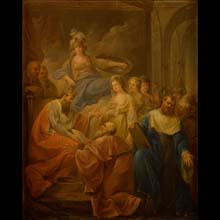
material: oil on canvas
dimensions: 66,5 x 52 cm
description: King Władysław Jagiełło, sitting on the throne, is handing the foundation charter of the renewed school to the rector of the Academy, who is kneeling before him. In 1400, when executing the will of his deceased wife, Queen Jadwiga, Jagiełło endowed the Academy of Krakow, established by Casimir the Great in 1364. The erection charter was issued on July 26, and academic activity was resumed. In accordance with the instructions of Stanisław August, the artist produced the painting that was reminiscent of Baroque canvases illustrating historical events with an allegorical commentary. The figures of Muses were to symbolize the faculties taught at the Academy. According to the historical descriptions prepared for the artist based on the chronicle of Długosz, the figures were originally intended to be the four faculties of the renewed school: liberal arts, theology, law and medicine. However, in the end, the artist decided to paint the Muses that were important from the perspective of the cultural policy of Stanisław August: Astronomy, Poetry and History and the figure of Minerva, goddess of wisdom, science, art and literature, above them. The allusions to the recent reform of the Krakow University, carried out by Hugo Kołłątaj in 1777, were clear for the people of the day. Nevertheless, as it was in the case of the illustration of the history of Casimir the Great, the Prussian Homage and the Polish-Lithuanian Union in Lublin, the picture does not tell much about the bygone years, since the artist was not able to accurately convey the architecture, clothes and other objects from the times more distant than the 17th century. Barbara Ciciora
exposition: The Gallery of 19th Century Polish Art in Sukiennice,
The Cloth Hall, 1, Main Market Square
key: Enlightenment >>>
dimensions: 66,5 x 52 cm
description: King Władysław Jagiełło, sitting on the throne, is handing the foundation charter of the renewed school to the rector of the Academy, who is kneeling before him. In 1400, when executing the will of his deceased wife, Queen Jadwiga, Jagiełło endowed the Academy of Krakow, established by Casimir the Great in 1364. The erection charter was issued on July 26, and academic activity was resumed. In accordance with the instructions of Stanisław August, the artist produced the painting that was reminiscent of Baroque canvases illustrating historical events with an allegorical commentary. The figures of Muses were to symbolize the faculties taught at the Academy. According to the historical descriptions prepared for the artist based on the chronicle of Długosz, the figures were originally intended to be the four faculties of the renewed school: liberal arts, theology, law and medicine. However, in the end, the artist decided to paint the Muses that were important from the perspective of the cultural policy of Stanisław August: Astronomy, Poetry and History and the figure of Minerva, goddess of wisdom, science, art and literature, above them. The allusions to the recent reform of the Krakow University, carried out by Hugo Kołłątaj in 1777, were clear for the people of the day. Nevertheless, as it was in the case of the illustration of the history of Casimir the Great, the Prussian Homage and the Polish-Lithuanian Union in Lublin, the picture does not tell much about the bygone years, since the artist was not able to accurately convey the architecture, clothes and other objects from the times more distant than the 17th century. Barbara Ciciora
exposition: The Gallery of 19th Century Polish Art in Sukiennice,
The Cloth Hall, 1, Main Market Square
key: Enlightenment >>>












